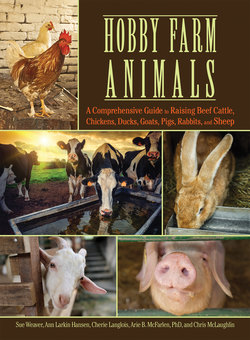Читать книгу Hobby Farm Animals - Chris McLaughlin - Страница 50
На сайте Литреса книга снята с продажи.
Outdoor Runs: Sunshine and Fresh Air
ОглавлениеAnother way to keep your chickens happy and healthy is to get them into sunshine and fresh air almost every day. To do that, you’ll probably need a chicken pen, or run, attached to your coop. You can allow your chickens to free-range (wander wherever they like), but “wherever they like” may be in your garden—or in your neighbor’s garden—or somewhere where predators can attack them. To save their skins—and your infinite vexation—consider providing a fenced-in area.
Chicken runs are traditionally crafted of chicken wire (also called poultry netting), which is a flimsy, 1-inch mesh woven into a honeycomb pattern. If a dog or larger varmint wants to get at your chickens, this lightweight mesh is not going to be a deterrent. If you value your birds, don’t use chicken wire as a barrier. Workable alternatives include substantial posts with attached medium- to heavy-duty yard fencing or sturdy wire sheep panels (sometimes installed two panels high), or electroplastic poultry netting.
If predators, including dogs, are an ongoing headache, a strong electric charger and two strands of electric wire fencing can provide effective but cheap insurance. String one strand on 10-inch extension insulators 4 inches from the ground, along the outside bottom of the run. Using the same type of insulator, stretch another strand parallel with the top of your existing fence. These wires will prevent hungry critters from scaling or tunneling under your chicken-run fence.
Allow at least 10 square feet of fenced run for each heavy chicken in your flock, 8 square feet per light-breed chicken, and 4 square feet per bantam. In general, you can contain your chickens using a 4–6-foot fence, but most bantams and certain light full-size breeds can neatly sail over 6-foot barriers. Keep them in by installing netting over the enclosure.
Straw works well as bedding to insulate the coop.
